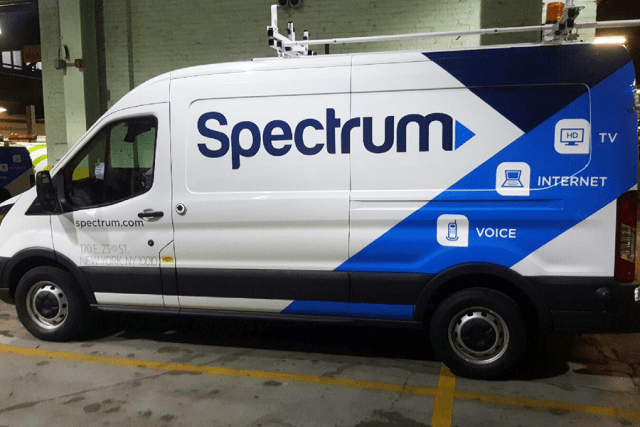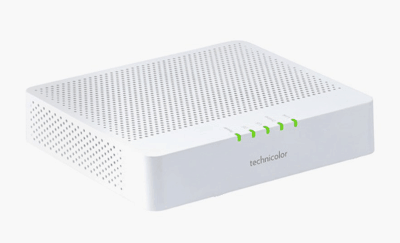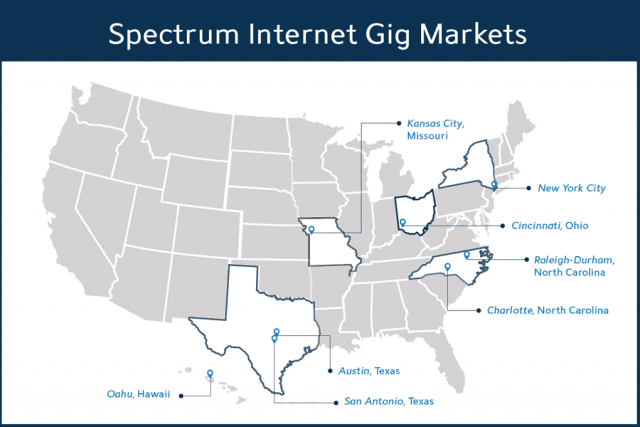 Most Charter Communications customers should now be experiencing Spectrum’s free holiday season speed upgrade as the company rolls out speed tiers ranging from 100-1,000Mbps. Customers have been sharing their stories about the speed changes, especially for former Time Warner Cable and Bright House customers that, in many areas, languished with maximum speeds of around 50Mbps for years.
Most Charter Communications customers should now be experiencing Spectrum’s free holiday season speed upgrade as the company rolls out speed tiers ranging from 100-1,000Mbps. Customers have been sharing their stories about the speed changes, especially for former Time Warner Cable and Bright House customers that, in many areas, languished with maximum speeds of around 50Mbps for years.
Most of the changes were noticed by customers around mid-December when Charter reprovisioned customer modems to reflect the new speed tiers. But some customers have had to call to get their modems refreshed to get the new speed upgrades. Others may need a new modem to take advantage of faster speeds. Since Spectrum does not charge a customer modem rental fee, if your speeds are inadequate with your current modem, it may not hurt to try one of theirs. Just remember they will often attempt to sell you added Wi-Fi service which you may not need for an additional $5 a month. This feature can be disabled to avoid the fee on any modem they provide if you already have your own router.
There has also been confusion because some cities are not yet fully upgraded to receive some of Spectrum’s fastest tiers and some current customers will not automatically qualify for speed upgrades until they talk to Spectrum customer service.
Premium Speed Price Reductions Arrive
Some good news — the premium prices Spectrum charges for its highest speed tiers are dropping to make room for the company’s new gigabit plan ($124.99), currently only available in a very limited service area. Spectrum Internet Ultra, which ranges in speed between 120-400Mbps depending on your service area is dropping from $104.99/mo to $89.99/mo ($79.99 if you have a television package). The original Spectrum Ultra upgrade setup fee – $199.99, has been reduced to $49.99.
If you subscribe to Internet Ultra, you may need to contact Spectrum to make sure they have provisioned your service at the new lower price. If you have any problems, refer them to Charter’s non-promotional rate card for your area, which should now show the new non-promotional/regular pricing.
Remember too that customers with legacy Time Warner Cable or Bright House packages and pricing will not receive speed upgrades.
Speed Changes in Select Areas
For many Spectrum customers, the speed increase introduces 100Mbps as the new Standard Spectrum internet speed, but in more than a dozen markets, even faster speeds are now available, at least for some customers.
In Austin, Tex., Charlotte, N.C., Cincinnati, Oh., Kansas City, Mo., New York, N.Y., Raleigh, N.C., and San Antonio, Tex.:
- Spectrum Internet Gig (up to 940/35Mbps) is now available
- Spectrum Internet Ultra (up to 400/20Mbps) for new customers (existing customers should check to see if they are still stuck at 300Mbps, the old speed)
- Spectrum Internet Standard (up to 200/10Mbps) for all customers, which includes a free speed boost.
Note: Current Internet Ultra customers may need to contact Spectrum to make arrangements for the speed upgrade. You may also need a new modem to qualify for 400Mbps speed.
In Bowling Green, Ky., Burlington, Vt., Dayton, Oh., Dallas-Ft. Worth, Tex., Evansville, Ind., Green Bay, Wisc., Greensboro, N.C., Greenville, N.C., Houston, Tex., Lexington, Ky., Los Angeles, Calif., Louisville, Ky., Milwaukee, Wisc., Palm Springs, Calif., San Diego, Calif., Syracuse, N.Y., Utica, N.Y., Waco, Tex., Watertown, N.Y., Wilmington, N.C., and Yuma, Ariz.:
- Spectrum Internet Ultra (up to 400/20Mbps) for new customers
- Spectrum Internet Ultra (up to 300/20Mbps) for existing customers, which represents no change.
Note: Some existing customers claim they have been upgraded to 400Mbps speed automatically, but others have had to contact Spectrum to make arrangements for the upgrade. You may also need a new modem to qualify for 400Mbps speed.
Experiencing Spectrum’s Gigabit Service

Technicolor 4400 DOCSIS 3.1 modem
Upgrading to gigabit speed will take more than a phone call with customer service. For now, Charter Communications insists on an in-home service call and a setup fee that was originally set at $199.99 but may have recently dropped. Some customers report getting the fee waived by complaining about it on Twitter and referencing in the tweet.
We have heard from customers in Texas and Hawaii that signed up for gigabit service and their stories are similar.
- Expect a service call lasting up to two hours. A technician, or more likely a few of them will be thoroughly testing the condition of your current cable lines, both inside and outside of the home. They have new testing equipment that is more sensitive than older testing equipment, and can spot signal problems, interference, or deteriorating infrastructure that will need to be repaired or replaced before service can be installed. In most cases, this can be done during the same service call.
- There are no authorized customer-owned modems for Spectrum’s gigabit internet at this time. Customers have received Technicolor TC4400-AM DOCSIS 3.1 modems during these early days of gigabit service. There will likely be others offered in the future.
- Customers can expect speeds to approach 940Mbps of download speed and close to 40Mbps for uploads if they own gigabit capable routers and reasonably modern computers. Expect wireless speeds to be significantly lower — sometimes by more than half, depending on the device, distance from the router, and the router itself. Spectrum technicians will probably strongly recommend the use of one of their routers.
- Faster speeds were noticeable downloading large files and streaming very high bandwidth multimedia, but average users may not notice a dramatic difference from gigabit speed while doing basic web browsing and other similar activities. But the larger installed base of gigabit-capable consumers will likely inspire future applications built to take advantage of that higher bandwidth.



 Subscribe
Subscribe
 It will take until 2019 to fully integrate all of Charter’s customers onto a single platform that will no longer distinguish if a customer was a long-standing Charter customer or a former TWC or BH subscriber.
It will take until 2019 to fully integrate all of Charter’s customers onto a single platform that will no longer distinguish if a customer was a long-standing Charter customer or a former TWC or BH subscriber. Charter did not restart its digital television conversion program until June of 2017, and 30% of Time Warner Cable and 50% of Bright House Networks customers are still watching analog cable television as a result. Company officials promise digital conversion will be completed nationwide by the end of this year, the first step the company will take to make dramatic broadband speed increases possible.
Charter did not restart its digital television conversion program until June of 2017, and 30% of Time Warner Cable and 50% of Bright House Networks customers are still watching analog cable television as a result. Company officials promise digital conversion will be completed nationwide by the end of this year, the first step the company will take to make dramatic broadband speed increases possible. Most Charter Communications customers should now be experiencing Spectrum’s free holiday season speed upgrade as the company rolls out speed tiers ranging from 100-1,000Mbps. Customers have been sharing their stories about the speed changes, especially for former Time Warner Cable and Bright House customers that, in many areas, languished with maximum speeds of around 50Mbps for years.
Most Charter Communications customers should now be experiencing Spectrum’s free holiday season speed upgrade as the company rolls out speed tiers ranging from 100-1,000Mbps. Customers have been sharing their stories about the speed changes, especially for former Time Warner Cable and Bright House customers that, in many areas, languished with maximum speeds of around 50Mbps for years.
 Charter Communications cable TV customers will soon see sweeping rate increases on their cable bills as the cable company announces its 2018 “rate adjustments” that will begin to take effect as early as next month in some markets.
Charter Communications cable TV customers will soon see sweeping rate increases on their cable bills as the cable company announces its 2018 “rate adjustments” that will begin to take effect as early as next month in some markets.